Genre: Shmup Developer: American Sammy Publisher: American Sammy Players: 1-2 Released: 1994
In 1992, Sammy released a shmup for the Neo Geo system that won best graphics and music from EGM’s 1992 buyer awards. Its name was Viewpoint, and it garnered a healthy amount of attention with its tough difficulty and interesting perspective. Two years later, American Sammy took up the challenge of bringing that game to the Genesis. They strove to cram a 74Mb Neo Geo game, into a 16Mb Genesis cartridge. How’d their efforts turn out? Read on.
In your Byupo Fighter, you must push back the enemy forces that are invading. They’ve taken on all sorts of forms, from ships and gun turrets, to mechanized worms, fish, crabs, and moths. It’s up to you to take them down, and you’ll have to do it on your own. So push your way through six levels and end the alien menace once and for all.
Graphically, the Genesis version does a good job of mimicking the polysprite style of the Neo Geo game. By “polysprite,” I mean that the graphics look polygonal in nature, but they’re actually sprites, and not real-time rendered polygons. It’s a given that the graphics are a step down from the original version. There are some details lost on parts of the stages, enemies, and so forth, and some enemies look like they were simplified a little in their design. However, this game isn’t an ugly one. It looks very good on Sega’s 16-bitter, with enemies and stages that are similar to how they appeared on the SNK machine. The graphic detail is pretty much constant throughout the game, showing that despite the cuts here and there, a lot of care went into recreating the original game’s look.
Like the graphics, the smooth animation that the SNK version is known for also suffered a few cuts here and there. Some enemy animations were reduced to only a couple frames, while other enemies are virtually identical to their Neo Geo counterpart in terms of fluid movement. The result is some visual inconsistency in this area. But for the most part, the animation level is surprisingly similar to the Neo Geo version.
The audio, while not having the super samples of the original game, holds its own. Some of the voice samples are still in the songs, it captures the somewhat quirky nature of the Neo Geo’s soundtrack, and it does a respectable job in recreating the feel of each tune with the new instruments. The sound effects aren’t as robust as what’s heard on the SNK machine, but they still sound alright. Charge shots, robotic insects, explosions… they get the job done. It’s safe to say that recreating the music seemed to be more of a priority, but the effects aren’t horrid by any means.
When it comes to the gameplay, the Genesis version matches the Neo Geo version. The enemy bullet spreads are just as tough, the enemy count is very close to being the same, and the stage-based obstacles can take you down just as fast. Even the bosses, many of which consist of multiple forms, are still intact for the most part.
In terms of weapons and bombs for fighting back, you get a basic shot to use, as well as a charge shot. You have three types of bombs, which consist of blue, red, and green. Blue causes several circles to appear on the ground to damage enemies, red sends two waves of fire up the screen that hurt enemies and block bullets, and green is a large spread of homing missiles. You can also pick up a pair of side guns to add a little more firepower to your ship (and block bullets), and you’ll find a handy shield in spots. All this adds up to the Genesis version reproducing the Neo-Geo version’s gameplay very well.
Despite how faithful this port is, it does suffer from a few issues. The first, and likely most noticeable one, is the slow down. This game is littered with it. Though it’s not hard to see why when you put all the bullets, enemies, and such on the screen (and in an isometric view to boot), it does happen quite a bit, and is a detriment to the game. Another issue is flicker. While it’s not as prominent as the slowdown, it can be seen down around where the score is when the game starts really chugging because a lot is on-screen, or on some big enemies when you get next to them horizontally. Thankfully, it doesn’t usually result in enemies and bullets turning invisible in the heat of battle.
Beyond those two major issues, the game is unfortunately missing some enemies (both regular ones, and some related to the bosses), and various effects or objects in the stages (water wavering, the bee hives coming up out of the ground, etc.). They’re minor things, but they do detract a little from the game’s visual aesthetic. One last thing of note… the hit detection. It’s not bad or broken, but the isometric view can lead to moments when you could swear you got between the bullets yet exploded anyway. This game’s viewing angle can be tricky to read, so bear that in mind.
In the end, what do we have with the Genesis version of Viewpoint? As an arcade port, it has its faults that result from memory constraints and less powerful hardware. As a game in general though, it’s very good. Sure, it took a small hit visually and aurally, and from a technical stand point, it has a couple issues. But it’s still a respectable port of a much bigger game, and the interesting qualities it inherited from its big brother on the SNK system still shine through. Most importantly though, it’s fun to play. Like Takara did with their SNK ports, American Sammy pulled off some magic in getting much of the Neo-Geo game into a Genesis cart. So don’t worry that it’s a somewhat toned down port. It’s a fun and challenging shmup that deserves a place in your Genesis library.
SCORE: 8 out of 10

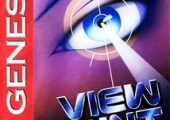
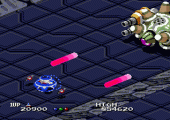
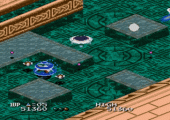
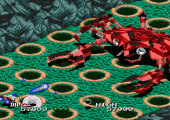
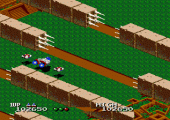
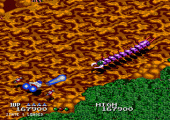
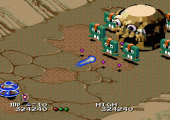
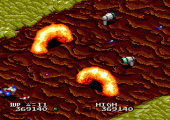
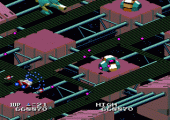
I like this game, but it needs to be pointed out there is no rapid fire and the setup of only one fire button cannot be changed.